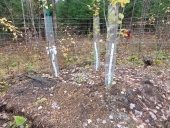
 2
2




 1
1








John Wolfram wrote:waiting a while




Bob Steve wrote:A week? Or longer?

 2
2




Bob Steve wrote:This will be my first year grafting... Is it possible to plant my rootstocks in buckets, do the graft and then plant them in the woods?
Owner, Etta Place Cider







 2
2




Bob Steve wrote:
Another question I have is about topworking a hardy crab apple tree I found growing in the brush. The problem is that I need to dig it out and replant it first... Is it best to wait until it re-establishes itself after replanting (say for a year) or can I do this type of graft right after replanting?
Bob Steve wrote:
Final question is about topworking another crab apple tree. This tree doesn't get much sun but it is 20 feet tall and over 30 years old. I think it gets most of it's spring/summer sun at sunrise and then towards sunset. Is there a specific kind or kinds of apple that I could graft to this? One that enjoys shade? It might need to be bark grafted... I'll take a picture of that one.
Owner, Etta Place Cider
 2
2




Ann Torrence wrote:
Yes, but if it's your first time and you are using dormant scions that you bought/traded and dormant rootstocks, why not do the graft first, indoors where there's good light and reasonable comfort to see what you are doing?
Ann Torrence wrote:
Many grafters will make the bench graft on dormant rootstock, then let the union "heal" in a dark, moist, protected environment for a week or so before planting out. Like wrapping the trees back up in the plastic bag it was shipped in with some wetted down packing material. If you aren't going to be there to monitor the trees where they are going, you could 1) plant in buckets until the graft heals well (several weeks), 2) use really short pieces of scion - I heard one of Jack Spirko's podcasts with the owner of Kuffel Creek in California who uses scions only one bud in length so that there is less chance of mechanical or wind breakage and/or 3) make the grafts at your kitchen table a week before you head off to the property to plant them. Maybe provide the joint with some extra support, wind protection.
There are a lot of ways to skin this cat, all will work. You can optimize your process later once you have some successes.
Ann Torrence wrote:
Either should work. It might be worth moving it but leaving it as a pollinator for your other apples. Crabs tend to bloom longer and overlap the short bloom windows of more demanding varieties. A little extra insurance until you know your chosen 20 have taken and fill each others' pollen needs.
Ann Torrence wrote:
I can't think of an apple that "enjoys" shade. But if it produces crabs, it would likely produce more desirable apples. If the tree isn't useful to you now, what's the harm in experimenting with some chip grafting this summer? That doesn't require a drastic revision of the existing tree to try out. Or if you have the space, leave this one for the birds?







 2
2




Bob Steve wrote:I'm looking for the best method aka the one where I'm least likely to lose my trees and waste scion wood because of improper planting etc.
Owner, Etta Place Cider




